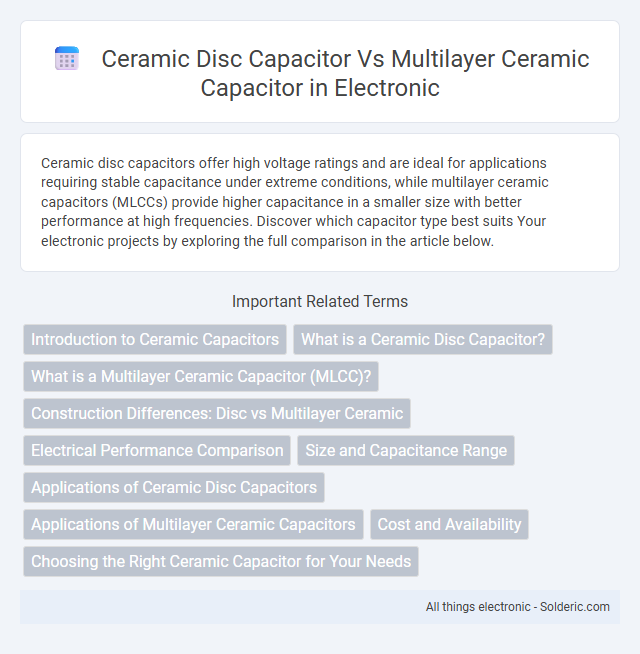Ceramic disc capacitors offer high voltage ratings and are ideal for applications requiring stable capacitance under extreme conditions, while multilayer ceramic capacitors (MLCCs) provide higher capacitance in a smaller size with better performance at high frequencies. Discover which capacitor type best suits Your electronic projects by exploring the full comparison in the article below.
Comparison Table
| Feature | Ceramic Disc Capacitor | Multilayer Ceramic Capacitor (MLCC) |
|---|---|---|
| Construction | Single ceramic disc with metalized electrodes | Multiple ceramic layers stacked with internal electrodes |
| Capacitance Range | 1 pF to 0.1 uF | 1 pF to 100 uF |
| Size | Generally larger, bulkier | Compact, small form factor |
| Frequency Response | Good for high frequency | Excellent high frequency performance |
| Application | Basic filtering and coupling in low to mid frequency circuits | Broad use: decoupling, filtering, and timing in high-density electronics |
| Stability & Reliability | Less stable, higher ESR | Highly stable with low equivalent series resistance (ESR) |
| Cost | Lower cost for lower capacitance values | More cost-effective for higher capacitance in small sizes |
Introduction to Ceramic Capacitors
Ceramic disc capacitors and multilayer ceramic capacitors (MLCCs) are essential passive components used in electronic circuits for stable capacitance and high-frequency performance. Ceramic disc capacitors typically feature a single ceramic dielectric layer with two conductive plates, making them suitable for high-voltage and high-frequency applications. MLCCs consist of multiple alternating ceramic and metal layers, providing higher capacitance values and better size-to-capacitance ratios, widely used in compact and surface-mount technology designs.
What is a Ceramic Disc Capacitor?
A ceramic disc capacitor is a type of capacitor characterized by a ceramic dielectric material sandwiched between two metal plates, typically shaped as a small, round disc. It offers stable capacitance values and low losses, making it ideal for high-frequency applications and general electronic circuits. Compared to multilayer ceramic capacitors (MLCCs), ceramic disc capacitors generally have larger physical sizes and higher voltage ratings but lower capacitance ranges.
What is a Multilayer Ceramic Capacitor (MLCC)?
A Multilayer Ceramic Capacitor (MLCC) consists of multiple layers of ceramic dielectric material stacked with alternating layers of metal electrodes, providing high capacitance in a compact size. MLCCs offer excellent stability, low losses, and high reliability, making them ideal for high-frequency applications in consumer electronics, automotive, and telecommunications. You can rely on MLCCs for superior performance where small size and high capacitance density are crucial.
Construction Differences: Disc vs Multilayer Ceramic
Ceramic disc capacitors feature a single ceramic disc with metalized coatings on each side, offering low cost and high voltage handling but limited capacitance values. Multilayer ceramic capacitors (MLCCs) consist of multiple thin ceramic layers stacked with internal electrodes, providing higher capacitance and smaller size for compact electronic designs. Your choice depends on application requirements such as capacitance, size, and voltage; MLCCs excel in miniaturization and capacitance, while disc capacitors are preferred for high voltage and robust performance.
Electrical Performance Comparison
Ceramic disc capacitors typically offer lower capacitance values and voltage ratings compared to multilayer ceramic capacitors (MLCCs), which provide higher capacitance in a smaller footprint due to their stacked layers. MLCCs exhibit superior frequency response and lower Equivalent Series Resistance (ESR), making them ideal for high-frequency and precision applications, whereas ceramic disc capacitors are more suited for general-purpose, high-voltage environments. Your choice depends on the required electrical performance, with MLCCs favored for compact, high-performance circuits and ceramic disc capacitors preferred for robustness in high-voltage scenarios.
Size and Capacitance Range
Ceramic disc capacitors typically offer larger physical sizes with capacitance values ranging from a few picofarads to several microfarads, making them suitable for applications requiring higher voltage ratings. Multilayer ceramic capacitors (MLCCs) are much smaller in size due to their stacked layer construction and provide a broad capacitance range from a few picofarads up to tens of microfarads, commonly used in compact electronic devices. MLCCs support higher capacitance density per volume compared to ceramic disc capacitors, enabling miniaturization in modern circuit designs.
Applications of Ceramic Disc Capacitors
Ceramic disc capacitors are widely used in power supplies, signal processing circuits, and general-purpose electronic devices due to their high voltage rating and excellent stability at high frequencies. They are preferred in applications requiring low loss and low leakage current, such as RF circuits, decoupling, and noise suppression. Their robust construction makes them ideal for automotive electronics, consumer electronics, and industrial equipment where durability and reliability are critical.
Applications of Multilayer Ceramic Capacitors
Multilayer Ceramic Capacitors (MLCCs) are widely used in applications requiring high capacitance and small size, such as in smartphones, computers, and automotive electronics for power supply decoupling and signal filtering. Their multilayer structure provides stable performance at high frequencies and voltages, making them ideal for RF circuits and precision analog systems. You can rely on MLCCs for compact, reliable, and efficient components in modern electronic devices.
Cost and Availability
Ceramic disc capacitors generally offer lower cost and higher availability due to their simple design and widespread manufacturing. Multilayer ceramic capacitors (MLCCs) tend to be more expensive because of their complex layering process and advanced materials, though they provide higher capacitance in a smaller form factor. Bulk procurement of ceramic disc capacitors is easier for standard values, while MLCCs may have lead time variability depending on capacitance and voltage ratings.
Choosing the Right Ceramic Capacitor for Your Needs
Selecting the right ceramic capacitor involves understanding the differences between ceramic disc capacitors and multilayer ceramic capacitors (MLCCs). Ceramic disc capacitors offer high voltage tolerance and stable performance for simple filtering, while MLCCs provide higher capacitance in a smaller size with better frequency response, ideal for surface-mount applications. Evaluate your circuit requirements for size, capacitance, voltage rating, and signal frequency to ensure optimal capacitor performance and longevity.
ceramic disc capacitor vs multilayer ceramic capacitor Infographic

 solderic.com
solderic.com